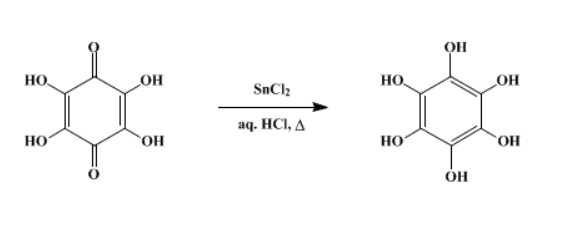hexahydroxy-benzene Chemische Eigenschaften,Einsatz,Produktion Methoden
R-S?tze Betriebsanweisung:
R11:Leichtentzündlich.
R38:Reizt die Haut.
R50/53:Sehr giftig für Wasserorganismen, kann in Gew?ssern l?ngerfristig sch?dliche Wirkungen haben.
R65:Gesundheitssch?dlich: kann beim Verschlucken Lungensch?den verursachen.
R67:D?mpfe k?nnen Schl?frigkeit und Benommenheit verursachen.
S-S?tze Betriebsanweisung:
S9:Beh?lter an einem gut gelüfteten Ort aufbewahren.
S16:Von Zündquellen fernhalten - Nicht rauchen.
S25:Berührung mit den Augen vermeiden.
S33:Ma?nahmen gegen elektrostatische Aufladungen treffen.
S60:Dieses Produkt und sein Beh?lter sind als gef?hrlicher Abfall zu entsorgen.
S61:Freisetzung in die Umwelt vermeiden. Besondere Anweisungen einholen/Sicherheitsdatenblatt zu Rate ziehen.
S62:Bei Verschlucken kein Erbrechen herbeiführen. Sofort ?rztlichen Rat einholen und Verpackung oder dieses Etikett vorzeigen.
Synthese
Hexahydroxy-benzene is synthesised using tetrahydroxyquinone as raw material by chemical reaction. The specific synthesis steps are as follows:
Step 1: One hundred grams (0.44 mole) of stannous chloride dihydrate is added to a boiling solution of 10 g. (0.058 mole) of tetrahydroxyquinone in 200 ml. of 2.4N hydrochloric acid contained in a 1.5-l. beaker. The initial deep-red color disappears, and grayish crystals of hexahydroxybenzene precipitate. Two hundred fifty milliliters of 12N hydrochloric acid is added, and the mixture is heated to boiling with constant stirring. The beaker is removed from the hot plate, an additional 600 ml. of 12N hydrochloric acid is added, and the solution is cooled in a refrigerator. The hexahydroxybenzene is collected on a Büchner funnel fitted with a sintered-glass disk and sucked dry.
Step 2: The crude hexahydroxybenzene is dissolved in 450 ml. of hot 2.4N hydrochloric acid containing 3 g. of hydrated stannous chloride and 1 g. of decolorizing carbon. The solution is filtered while hot, and the carbon is rinsed with 75 ml. of boiling water that is combined with the filtrate. One liter of 12N hydrochloric acid is added, and the mixture is cooled in a refrigerator. The snow-white crystals of hexahydroxybenzene that separate are collected under carbon dioxide or nitrogen on a Büchner funnel fitted with a sintered-glass disk. The hexahydroxybenzene is washed with 100 ml. of a cold 1:1 mixture of ethanol and 12N hydrochloric acid and dried in a vacuum desiccator over sodium hydroxide pellets; yield 7.1–7.8 g. (70–77%). It fails to melt on a hot plate at 310°.

hexahydroxy-benzene Upstream-Materialien And Downstream Produkte
Upstream-Materialien
Downstream Produkte

